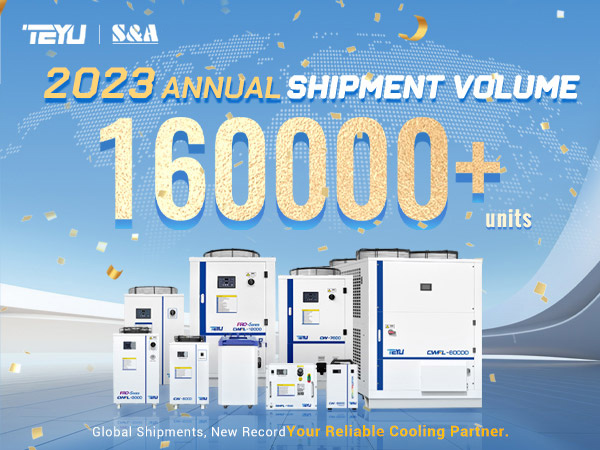3D printers can be classified into various types based on different technologies and materials. Each type of 3D printer has specific temperature control needs, and thus the application of water chillers varies. Below are the common types of 3D printers and how water chillers are used with them.
3D printing or additive manufacturing is the construction of a three-dimensional object from a CAD or a digital 3D model, which has been used in manufacturing, medical, industry, and sociocultural sectors... 3D printers can be classified into various types based on different technologies and materials. Each type of 3D printer has specific temperature control needs, and thus the application of water chillers varies. Below are the common types of 3D printers and how water chillers are used with them:
1. SLA 3D Printers
Working Principle: Uses a laser or UV light source to cure liquid photopolymer resin layer by layer.
Chiller Application: (1)Laser Cooling: Ensures the laser operates stably within the optimal temperature range. (2)Build Platform Temperature Control: Prevents defects caused by thermal expansion or contraction. (3)UV LED Cooling (if used): Prevents UV LEDs from overheating.
2. SLS 3D Printers
Working Principle: Uses a laser to sinter powder materials (e.g., nylon, metal powders) layer by layer.
Chiller Application: (1)Laser Cooling: Needed to maintain laser performance. (2)Equipment Temperature Control: Helps maintain a stable temperature in the entire printing chamber during the SLS process.
3. SLM/DMLS 3D Printers
Working Principle: Similar to SLS, but primarily for melting metal powders to create dense metal parts.
Chiller Application: (1)High-Power Laser Cooling: Provides effective cooling for the high-power lasers used. (2)Build Chamber Temperature Control: Ensures consistent quality in metal parts.
4. FDM 3D Printers
Working Principle: Heats and extrudes thermoplastic materials (e.g., PLA, ABS) layer by layer.
Chiller Application: (1)Hotend Cooling: While not common, high-end industrial FDM printers might use chillers to precisely control the hotend or nozzle temperature to prevent overheating. (2)Environmental Temperature Control**: Used in some cases to maintain a consistent printing environment, especially during long or large-scale prints.
5. DLP 3D Printers
Working Principle: Uses a digital light processor to project images onto photopolymer resin, curing each layer.
Chiller Application: Light Source Cooling. DLP devices typically use high-intensity light sources (e.g., UV lamps or LEDs); water chillers keep the light source cool to ensure stable operation.
6. MJF 3D Printers
Working Principle: Similar to SLS, but uses a jetting head to apply fusing agents onto powder materials, which are then melted by a heat source.
Chiller Application: (1)Jetting Head and Laser Cooling: Chillers cool the jetting head and lasers to ensure efficient operation. (2)Build Platform Temperature Control: Maintains platform temperature stability to avoid material deformation.
7. EBM 3D Printers
Working Principle: Uses an electron beam to melt metal powder layers, suitable for manufacturing complex metal parts.
Chiller Application: (1)Electron Beam Gun Cooling: The electron beam gun generates significant heat, so chillers are used to keep it cool. (2)Build Platform and Environment Temperature Control: Controls the temperature of the build platform and the printing chamber to ensure part quality.
8. LCD 3D Printers
Working Principle: Uses an LCD screen and UV light source to cure resin layer by layer.
Chiller Application: LCD Screen and Light Source Cooling. Chillers can cool high-intensity UV light sources and LCD screens, extending equipment life and improving print precision.
How to Choose the Right Water Chillers for 3D Printers?
Choosing the Right Water Chiller: When selecting a water chiller for a 3D printer, consider factors such as heat load, temperature control accuracy, environmental conditions, and noise levels. Ensure the water chiller's specifications meet the cooling requirements of the 3d printer. To guarantee optimal performance and longevity of your 3D printers, it is advisable to consult with the 3d printer manufacturer or water chiller manufacturer when choosing a water chiller.
TEYU S&A’s Advantages: TEYU S&A Chiller is a leading chiller manufacturer with 22 years of experience, providing tailored cooling solutions for various industrial and laser applications, including different types of 3D printers. Our water chillers are known for their high efficiency and reliability, with over 160,000 chiller units sold in 2023. The CW series water chillers offer cooling capacities from 600W to 42kW and are suitable for cooling SLA, DLP, and LCD 3D printers. The CWFL series chiller, developed specifically for fiber lasers, is ideal for SLS and SLM 3D printers, supporting fiber laser processing equipment from 1000W to 160kW. The RMFL series, with a rack-mounted design, is perfect for 3D printers with limited space. The CWUP series offers temperature control precision up to ±0.08°C, making it suitable for cooling high-precision 3D printers.

We're here for you when you need us.
Please complete the form to contact us, and we'll be happy to help you.
Copyright © 2025 TEYU S&A Chiller - All Rights Reserved.